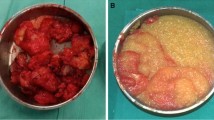Abstract
Background
Polyacrylamide gel (PAAG) migration after esthetic breast injection is clinically variable and complex, and thus, the rate of incomplete removal after debridement is high.
Objectives
We aimed to describe a practical classification system for PAAG migration after breast injection and evaluate the outcome of our management.
Methods
A retrospective review of medical records was conducted for patients who presented to our institution for the management of PAAG migration after injection augmentation mammaplasty from June 2013 to November 2018. PAAG migration was evaluated by MRI examination and classified based on the migrating direction outside the breast contour. Surgery was performed to remove the material completely through different incisions.
Results
Seventy-eight women met the study criteria, with 106 breasts identified as showing PAAG migration. Patients were classified as having superior (22%), lateral (25%), inferior (34%), medial (10%) or complex (9%) PAAG displacement. The mean follow-up was 9 months (range 3–18 months). Postoperative complications included seroma (n = 3), delayed wound healing (n = 2), occasional breast pain (n = 5) and paresthesia or numbness at the migrated site (n = 2). MRI re-examination revealed that most of the injected material was removed, and no patient needed a secondary debridement operation.
Conclusion
PAAG migration after injection augmentation mammaplasty can be clinically characterized into different types based on the migrating direction. It is helpful to perform MRI examinations preoperatively to fully evaluate PAAG migration. Under the guidance of our classification system, the injected material could be effectively eradicated with an acceptable complication rate.
Level of Evidence III
This journal requires that authors assign a level of evidence to each article. For a full description of these Evidence-Based Medicine ratings, please refer to the Table of Contents or the online Instructions to Authors www.springer.com/00266.



Similar content being viewed by others
References
Ono S, Ogawa R, Hyakusoku H (2010) Complications after polyacrylamide hydrogel injection for soft-tissue augmentation. Plast Reconstr Surg 126:1349–1357
Unukovych D, Khrapach V, Wickman M, Liljegren A, Mishalov V, Patlazhan G (2012) Polyacrylamide gel injections for breast augmentation: management of complications in 106 patients, a multicenter study. World J Surg 36:695–701
Cheng NX, Wang YL, Wang JH et al (2002) Complications of breast augmentation with injected hydrophilic polycrylamide gel. Aesth Plast Surg 26:375–382
Luo SK, Chen GP, Sun ZS et al (2011) Our strategy in complication management of augmentation mammaplasty with polyacrylamide hydrogel injection in 235 patients. J Plast Reconstr Aesthet Surg 64:731–737
Cheng NX, Xu SL, Deng H et al (2006) Migration of implants: a problem with injectable polyacrylamide gel in aesthetic plastic surgery. Aesth Plast Surg 30:215–225
Chen L, Sha L, Huang SP et al (2015) Treatment for displacement of PAAG mixture after injection augmentation mammoplasty. Int J Clin Exp Med 8:3360–3370
Patlazhan G, Unukovych D, Pshenisnov K (2013) Breast reconstruction and treatment algorithm for patients with complications after polyacrylamide gel injections: a 10-year experience. Aesth Plast Surg 37:312–320
Wang Z, Li S, Wang L et al (2012) Polyacrylamide hydrogel injection for breast augmentation: another injectable failure. Med Sci Monit 18:CR399–CR408
Bjarnsholt T, Tolker-Nielsen T, Givskov M, Janssen M, Christensen LH (2009) Detection of bacteria by fluorescence in situ hybridization in culture-negative soft tissue filler lesions. Dermatol Surg 35:1620–1624
Khedher NB, David J, Trop I, Drouin S, Peloquin L, Lalonde L (2011) Imaging findings of breast augmentation with injected hydrophilic polyacrylamide gel: patient reports and literature review. Eur J Radiol 78:104–111
Margolis NE, Bassiri-Tehrani B, Chhor C, Singer C, Hernandez O, Moy L (2015) Polyacrylamide gel breast augmentation: report of two cases and review of the literature. Clin Imaging 39:339–343
Chen B, Song H (2016) Management of breast deformity after removal of injectable polyacrylamide hydrogel: retrospective study of 200 cases for 7 years. Aesth Plast Surg 40:482–491
Author information
Authors and Affiliations
Corresponding authors
Ethics declarations
Conflict of interest
The authors declare that they have no conflict of interest.
Ethical Approval
Institutional review board approval was obtained for a medical record review.
Informed Consent
Informed consent was obtained from all patients for the use of their data.
Additional information
Publisher's Note
Springer Nature remains neutral with regard to jurisdictional claims in published maps and institutional affiliations.
Rights and permissions
About this article
Cite this article
He, J., Wang, T. & Dong, J. Classification and Management of Polyacrylamide Gel Migration After Injection Augmentation Mammaplasty: A Preliminary Report. Aesth Plast Surg 44, 1516–1521 (2020). https://doi.org/10.1007/s00266-020-01912-x
Received:
Accepted:
Published:
Issue Date:
DOI: https://doi.org/10.1007/s00266-020-01912-x




